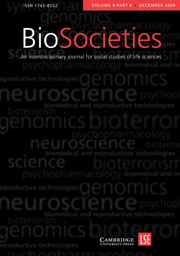Article contents
Participation and the New Governance of Life
Published online by Cambridge University Press: 01 September 2008
Abstract
In the article we report on the findings of an EU-funded research project,Paganini (Participatory Governance and Institutional Innovation), thatinvestigated the question of whether ‘politics of life’themes have led to the emergence of new forms of governance in Europe. The focusof our research was on human embryonic stem cell research, genetic testing, GMcrops, and BSE in the United Kingdom, Germany, Austria, the Netherlands, and onthe EU level—hotly contested topics at the intersection of society,politics, nature and the human body. We argue that, in the domain oflife-political issues, the notions of participation and governance have becomeintermingled to an unusual extent. Our case studies demonstrate that the conceptof participation needs to be rethought. While‘spontaneous’ public participation certainly still is apolitical fact, increasingly participation has turned into a‘technology’ that is based on the construction ofpublics. Different participatory technologies are linked to a changinglandscape of political subjects considered relevant to the debate. As the casestudies have shown, the design of any formal participatory arrangement involvesa considerable amount of ‘engineering’, includingarrangements seeking to invite a ‘representative’,disinterested, ‘pure’ public. There is no such thing as‘the public’ waiting for pure representation. Formalparticipatory arrangements are inevitably based on a process of activeconstruction, involving goal setting, selection, decision making andprioritization, including the decision to prioritize the pure public at theexpense of engaged publics. What seems to be occurring today is that‘old’ definitions of social order no longer hold andvarious groups try to impose new (partial) definitions of a new order on others.A new, postmodernist logic seems to be spinning new relations amongcitizens/consumers and scientists and administrators. Thus, there is no singleNew Way of governing Europe.
Information
- Type
- Articles
- Information
- Copyright
- Copyright © London School of Economics and Political Science 2008
References
- 61
- Cited by

